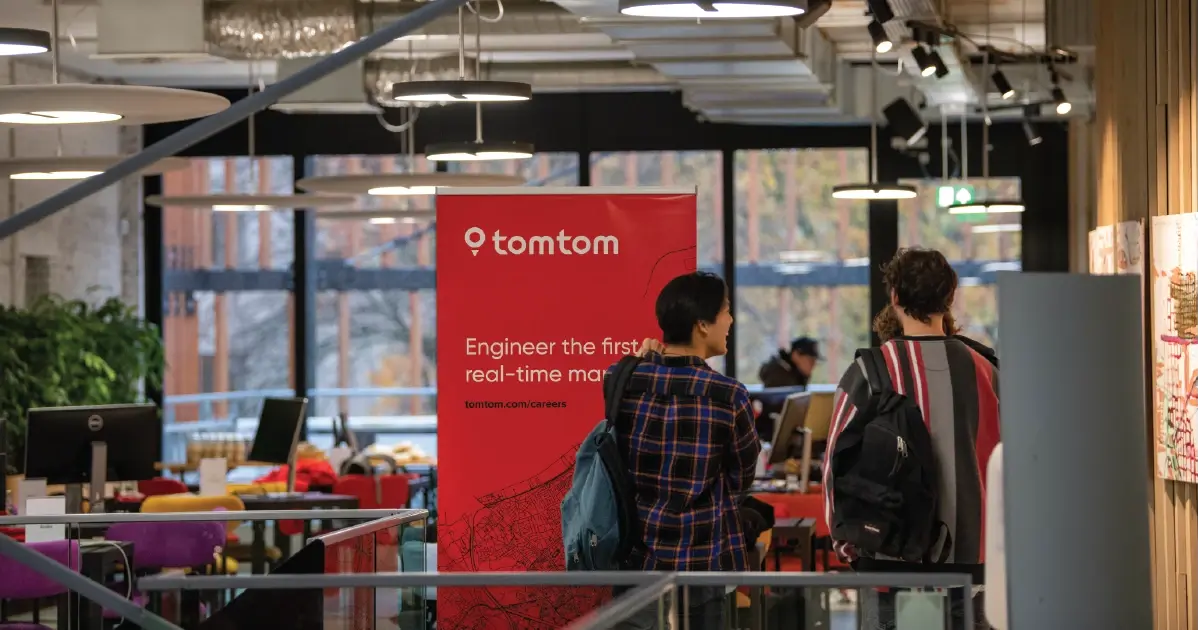Generative AI Journey at TomTom
Since its debut in December 2022, ChatGPT has highlighted the transformative potential of Generative AI (GenAI). Unlike traditional AI, GenAI generates data in various formats and interprets context, mimicking human-like responses. Early research indicates GenAI can improve task performance by 30-60%, boosting productivity significantly. Despite challenges like hallucinations and potential confidentiality breaches of using GenAI, TomTom takes a strategic approach to leverage GenAI to enhance competitiveness, realize substantial value, and manage risks effectively.
Our GenAI Timelines
 In less than a year’s investment in GenAI innovation, TomTom has introduced to the world a ChatGPT location plugin, an AI assistant for in-car digital cockpits (Tommy), and has launched several internal GenAI applications that simplify mapmaking and location technology development. We achieved these without substantial additional investments or a large influx of new hires. This experience provided valuable insights and helped crystalize our strategy. In this engineering blog, we’re pulling back the curtain on our generative AI adventure at TomTom.
In less than a year’s investment in GenAI innovation, TomTom has introduced to the world a ChatGPT location plugin, an AI assistant for in-car digital cockpits (Tommy), and has launched several internal GenAI applications that simplify mapmaking and location technology development. We achieved these without substantial additional investments or a large influx of new hires. This experience provided valuable insights and helped crystalize our strategy. In this engineering blog, we’re pulling back the curtain on our generative AI adventure at TomTom.
Our GenAI Strategy
In Rumelt style, we formulate our GenAI strategy as follows.
The diagnosis: to stay competitive, TomTom must adapt its location tech for AI uses externally, while internally streamlining operations with AI to unlock new revenue, maintain relevance, improve quality and cut costs.
The guiding policy: democratize innovation by allowing individual teams to explore GenAI with modest budgets and fast prototyping; prioritize projects based on impact and team readiness; provide central expertise and oversight to align innovation with business goals.
The coherent actions:
- Distribute our resources in small, coordinated ventures for broader coverage and risk mitigation through a hub-and-spoke model.
- Prioritize delivering impactful in-house products over conducting fundamental research.
- Partner with academia and startups for early R&D; partner with cloud providers on foundational models and infrastructure.
- Establish a GenAI center of excellence and upskill our workforce to stay ahead in the evolving tech landscape.
Our strategy unfolds by 1) targeting the opportunities areas of GenAI, 2) building an infrastructure to amplify innovation, and 3) implementing extensive upskilling for our workforce.
1. Opportunity Areas for GenAI in Location Technology
GenAI’s foundational models offer advanced AI capabilities to various applications, eliminating the need for hefty upfront investments or extensive in-house AI expertise. This paves the way for new opportunities in growth, efficiency, and quality previously deemed infeasible (Andrew Ng’s talk on Opportunities in AI). We choose to focus our innovative efforts on applications development, and closely partner with cloud providers like Azure OpenAI to leverage their evolving GenAI capabilities. This enables teams to reduce development time from quarters as with traditional AI, to mere weeks with GenAI, and eliminates the need for resident AI specialists in every team. This new pattern encourages us to reconsider business opportunities to apply AI across many tail applications. With strategic investment. These tail cases in aggregate can yield substantial ROI in terms of quality and productivity improvements.
We prioritize purchasing over building non-core applications such as AI tools in Office, Enterprise Search, Salesforce, Workday, etc. For occasional uses like Artificial Intelligence-Generated Content (AIGC), we look to 3rd party solutions. For applications within TomTom’s core expertise, we explore cost-effective applications and avoid building foundational models due to upfront cost and ROI concerns.

In location technology, we explore opportunities in two primary areas. Firstly, we identify parts in the existing workflows that can benefit from GenAI’s automation and human-augmentation capabilities. This involves refining our current workflow as we construct location data, and build services, SDKs, and applications. Secondly, we use GenAI to enhance and improve the overall user experience. In the context of TomTom’s products, we’re leveraging GenAI to provide a safer, superior driving experience and a seamless developer experience for our APIs and SDKs.
2. Structure to Democratize Innovation
 We deploy a hub-and-spoke model to structure and scale our innovation efforts. Our Innovation Hub is a compact group of GenAI specialists who oversee strategic directions and boost GenAI proficiency across the organization. This team is responsible for core AI applications, such as the Location plugin for ChatGPT, the AI assistant, Tommy, in TomTom’s digital cockpit, and a chatbot with developer documentation. Once the AI component has matured, product ownership will be transferred to dedicated teams. The hub team also offers centralized coordination, guides infrastructure decisions, and provides operational support. We will examine the four aspects below, i.e. core AI applications, sponsored projects, tooling and guidelines.
We deploy a hub-and-spoke model to structure and scale our innovation efforts. Our Innovation Hub is a compact group of GenAI specialists who oversee strategic directions and boost GenAI proficiency across the organization. This team is responsible for core AI applications, such as the Location plugin for ChatGPT, the AI assistant, Tommy, in TomTom’s digital cockpit, and a chatbot with developer documentation. Once the AI component has matured, product ownership will be transferred to dedicated teams. The hub team also offers centralized coordination, guides infrastructure decisions, and provides operational support. We will examine the four aspects below, i.e. core AI applications, sponsored projects, tooling and guidelines.
Core AI Application Examples
At TomTom, our goal is to deliver an exceptional user experience. We continually seek opportunities to enhance this experience through the use of AI in our core applications, with the hub team leading the charge. For drivers using TomTom’s navigation system, we provide Tommy. We provide access to location technology to both first and third party AI applications, such as ChatGPT. We enhance the developer experience by offering a chat interface to our documentation for those utilizing our APIs and SDKs.
Read more about how we built the world’s first location plugin for ChatGPT
Try the chat experience with TomTom’s developer documentation (coming soon):
Sponsored Projects
Our Spokes, local teams with considerable domain knowledge and business understanding, are equipped with an understanding of GenAI’s potential. This positions them to identify opportunities for GenAI applications within their domain, and they retain ownership of these solutions following their creation in collaboration with the hub. We refer to these as sponsored projects.
To fund a sponsored project, the hub and spoke teams work together to frame the problem, outline anticipated outcomes and impact, and design the solution. Both would allocate a small amount of resources to jointly develop a proof-of-concept (POC) solution - typically a task for 1-2 people over a few weeks. This close collaboration continues for a few months for ongoing iteration and feedback, resulting in a “seed” product or process. Once the product matures, the hub team provides consultative support as necessary, while the spoke team takes over full product ownership and maintenance. We periodically review temporarily unfunded projects, reassessing their opportunity and potential.
The hub team supervises the sponsored projects portfolio, assessing project and tech maturity, team preparedness, and risk. We prioritize teams with early adopters of GenAI technology, and transfer project ownership beyond the POC stage to the appropriate teams. We hold off on ideas that might benefit from future tech advancements and discourage ideas unrelated to TomTom’s core business, favoring purchasing instead. This approach focuses broader innovation on the core business and enables the hub team to concentrate on new explorations.
This framework promotes GenAI’s broad impact across different teams while enabling the central team to develop expertise, share knowledge, spot common trends, and identify opportunities for reuse and simplification on a company level. We keep track of these sponsored projects and their production effects, as well as their realized impact. This method allows us to scale innovation with a small team of specialists, and upskill the broader teams through collaboration.
AI @ Work Tooling
In addition to applying GenAI in product development, TomTom’s innovation hub partners with Digital Workplace and Infra (CCoE) teams to bring AI @ work tooling to broader functions. This includes making GenAI tools available to employees, coordinating training, and building community around the tool use to facilitate knowledge sharing. In 2023, we launched several initiatives: Github Copilot; ‘Chatty’, an open-source, internally hosted version of ChatGPT available at https://github.com/rijnb/chatty-server/ for enhanced data privacy; an AI code review tool; and the Microsoft 365 CoPilot, which is set to begin its beta trial in the coming weeks.
Throughout 2023, our teams utilized GenAI for various tasks such as analyzing search logs, classifying search intent, calibrating search confidence, creating live event services from social media data, conducting AI-assisted code reviews, generating release notes, triaging tickets, and interacting with internal documents. We will share more details about these projects and tools in a series of upcoming engineering blogs.
Guideline for Responsible Use of GenAI
We prioritize data governance and offer guidelines for responsible use of GenAI. GenAI poses certain challenges like hallucination, where the output seems plausible but is factually incorrect, or lack of awareness of the broader context. To address this, we not only incorporate knowledge grounding techniques in our product and process development, but also conduct training sessions to raise awareness about such risks and prevent misuse. We’ve deployed an in-house version of ChatGPT, both as a measure to safeguard sensitive data and to standardize GenAI best practices. This also improves communication via shared templates. We will continue to monitor the landscape and update our guidelines as technology and regulations evolve. See a section of our guideline for GenAI use below:
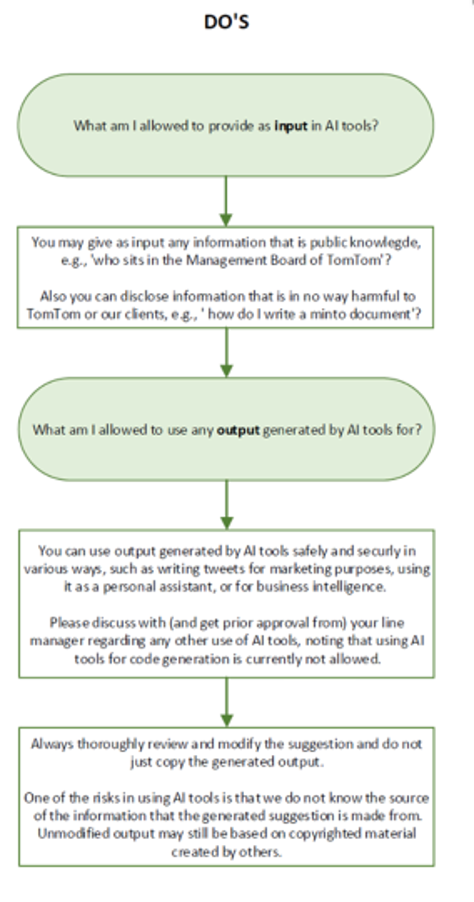
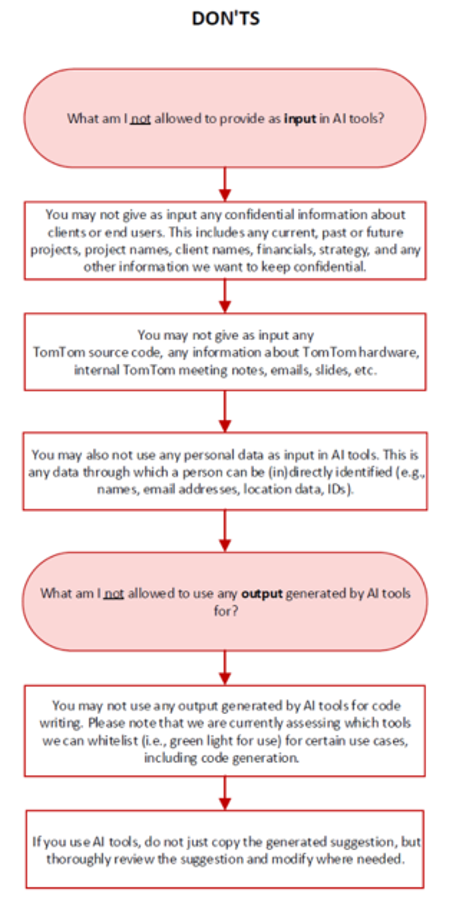
3. Fostering Innovation by Upskilling the Workforce
The prevalent concern that technological progress could diminish the workforce is exaggerated. As of 2023, GenAI technology has not advanced to the point of supplanting human roles. Our guiding principle is “stay vigilant,” aka. “Do not fall asleep at the wheel”. We have invested in a variety of tactics at TomTom to enhance learning, promote knowledge sharing, raise GenAI awareness, and foster innovation. Here are some of our favorite upskilling methods that have demonstrated initial success for aligning the organizations, and delivering results without significant increase in innovation budget.
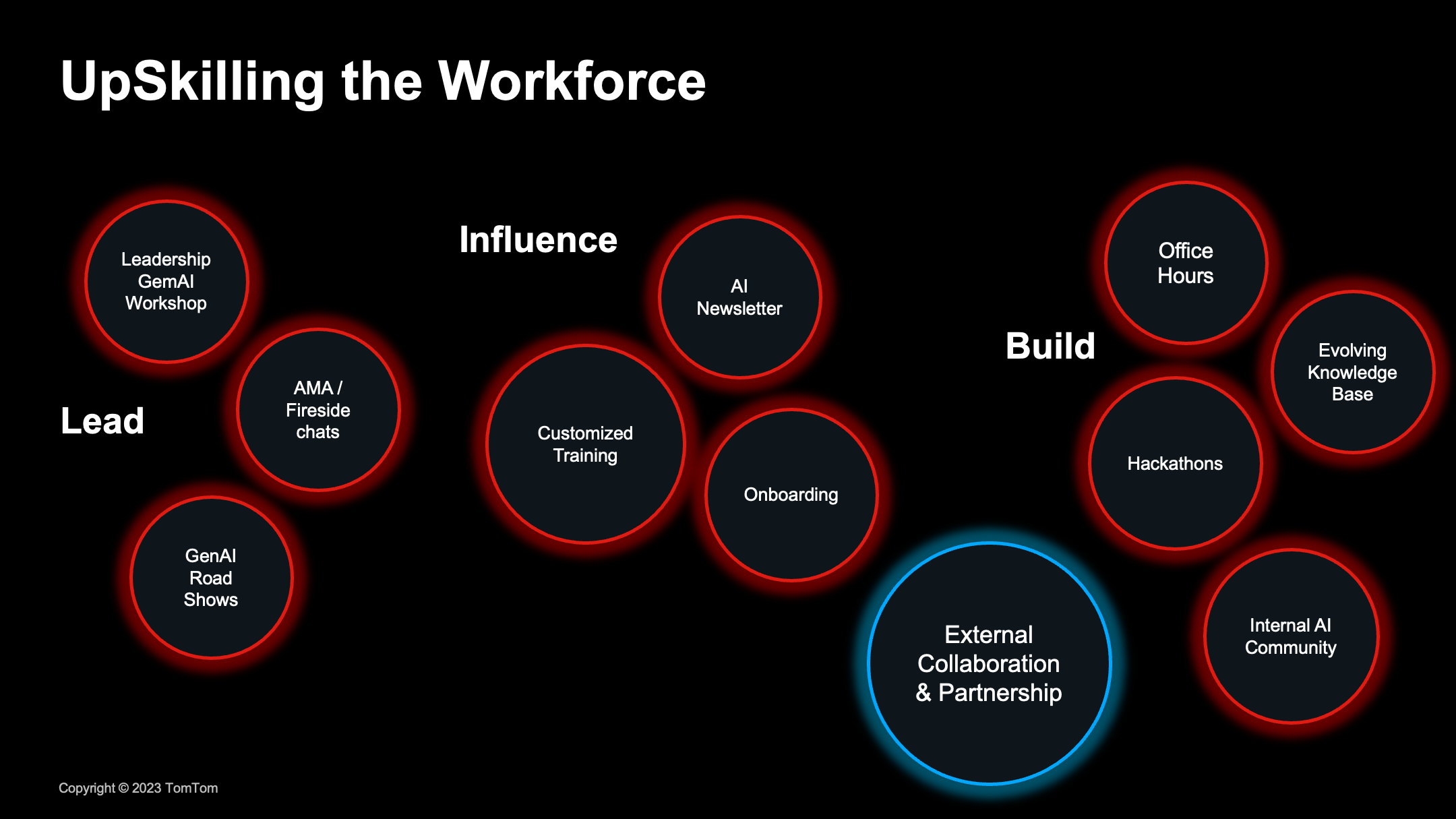 We drive leadership alignment through dynamic GenAI workshops, engaging department heads from marketing to HR, igniting innovative thinking and understanding of GenAI’s transformative power. By collaborating closely with customer support and product teams via targeted roadshows, the hub team sharpens product prioritization, informed by customer insights and tech prowess. This synergy shapes our GenAI communication for all customer interactions. Through regular AMAs, we transparently share our GenAI strategy, spotlight achievements, and address emerging topics. Fireside chats with GenAI pioneers further enrich our perspective, keeping our leadership at the cutting edge of innovation.
We drive leadership alignment through dynamic GenAI workshops, engaging department heads from marketing to HR, igniting innovative thinking and understanding of GenAI’s transformative power. By collaborating closely with customer support and product teams via targeted roadshows, the hub team sharpens product prioritization, informed by customer insights and tech prowess. This synergy shapes our GenAI communication for all customer interactions. Through regular AMAs, we transparently share our GenAI strategy, spotlight achievements, and address emerging topics. Fireside chats with GenAI pioneers further enrich our perspective, keeping our leadership at the cutting edge of innovation.
We propel TomTom’s GenAI savvy by delivering a weekly AI newsletter, keeping teams abreast of the latest advancements and fostering knowledge sharing. This initiative has not only grown its readership but also catalyzed new GenAI projects. New hires, both in engineering and other roles, are now equipped with GenAI tooling guides and best practices from day one, ensuring productive and responsible use. Engineers receive curated training and engaging tech talks to hone their skills, while non-engineering staff benefit from customized training that demystifies GenAI’s industry-specific uses. This strategic investment has significantly magnified the reach and effectiveness of our innovation team.
We champion experiential learning as the best route to workforce upskilling. In 2023, we hosted two GenAI hackathons, nurturing innovative ideas and swift implementation, with several winning solutions now in production. The Hub team’s “office hours” facilitate consultations and project mentorship across TomTom teams, fostering collaborative ideation. We also actively nurture internal GenAI communities to accelerate mutual learning and pattern recognition. Further extending our influence, we sustain an evolving knowledge base, promoting open knowledge sharing and encouraging teams to present their solutions, bolstering cohesive external communication. This hands-on approach empowers teams with GenAI proficiency, leading to impactful business results.
We strategically partner with tech leaders like Microsoft/Azure and BentoML to power our core AI solutions, ensuring we stay at the forefront of innovation. Additionally, we’ve established an internship program to explore and develop high-potential ideas — interested candidates can apply here. By actively engaging in tech talks, podcasts, and the wider community, we leverage collective knowledge and drive the advancement of this swiftly progressing technology.
Through the initiatives implemented in 2023, we’ve successfully delivered GenAI products, optimized workflows, and upskilled our workforce, all achieved without significantly increasing budgets or expanding team size.
What’s next?
We anticipate substantial tech advancements in the next 3-5 years, but this won’t deter our current innovation with GenAI. We’ll continue investing in GenAI applications for location technology, optimize our portfolio of initiatives on ROI, monitor our progress, and track success metrics. We intend to keep an eye on technological shifts and regulatory changes, and adjust our strategy as needed. We plan to hold biannual audits and strategy reviews to assess GenAI initiatives, using Azure ML’s responsible AI guidelines. We also aim to join broader industry discussions on responsible AI use and formulate our proactive risk-mitigation plans.
Conclusion
In conclusion, at TomTom, we are committed to leveraging GenAI responsibly to elevate the experience of our drivers, OEMs, and developers, while also streamlining our internal operations to increase efficiency and quality. We have designedthis strategic approach to produce significant value for our stakeholders. Looking ahead, we expect to unlock even more innovation with GenAI in 2024 – stay tuned for exciting developments!
Interact with Tommy at our CES booth in Jan 2024 at Las Vegas! Register now to take a sneak peek.
Follow our engineering blog for upcoming content on GenAI applications in location technology. If you are a student, consider interning with us on GenAI applications.
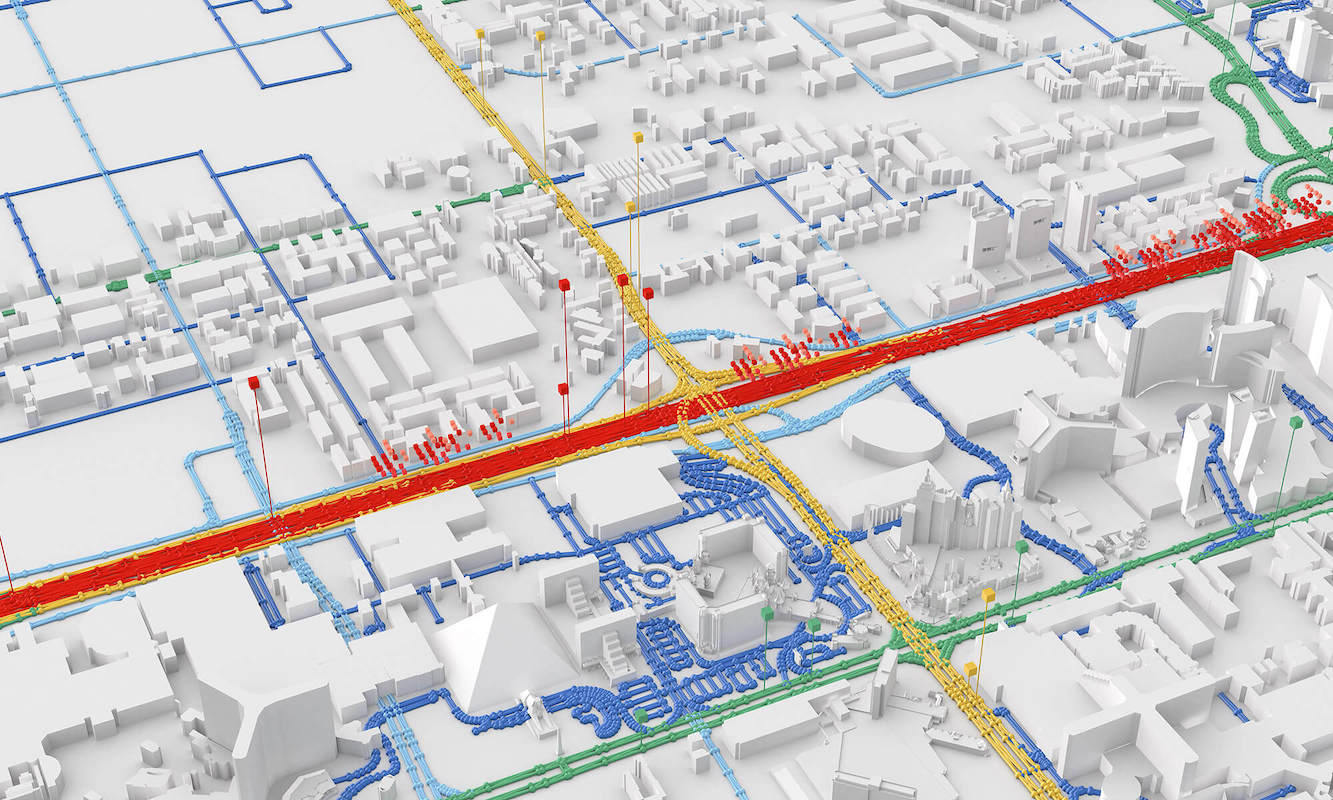
 Kubernetes multi-tenancy with Capsule
Kubernetes multi-tenancy with Capsule